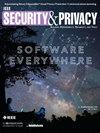软件弱点重现的十年。
IF 2.9
4区 计算机科学
Q2 COMPUTER SCIENCE, INFORMATION SYSTEMS
引用次数: 4
摘要
公共弱点枚举(Common Weakness Enumeration, CWE)社区发布了一个综合度量来计算“最危险的软件错误”。然而,所使用的方程高度偏向于频率,而不是可利用性和影响。我们提供了一个度量来减轻这种偏见,并讨论了过去十年中最重要的软件弱点。本文章由计算机程序翻译,如有差异,请以英文原文为准。
A Decade of Reoccurring Software Weaknesses.
The Common Weakness Enumeration (CWE) community publishes an aggregate metric to calculate the 'Most Dangerous Software Errors.' However, the used equation highly biases frequency over exploitability and impact. We provide a metric to mitigate this bias and discuss the most significant software weaknesses over the last ten years.
求助全文
通过发布文献求助,成功后即可免费获取论文全文。
去求助
来源期刊

IEEE Security & Privacy
工程技术-计算机:软件工程
CiteScore
4.30
自引率
5.30%
发文量
159
审稿时长
6-12 weeks
期刊介绍:
IEEE Security & Privacy’s primary objective is to stimulate and track advances in security, privacy, and dependability and present these advances in a form that can be useful to a broad cross-section of the professional community—ranging from academic researchers to industry practitioners. It provides articles with both a practical and research bent by the top thinkers in the field of security and privacy, along with case studies, surveys, tutorials, columns, and in-depth interviews and podcasts for the information security industry.
Through special issues, the magazine explores other timely aspects of privacy in areas such as usable security, the Internet of Things, cloud computing, cryptography, and big data. Other popular topics include software, hardware, network, and systems security, privacy-enhancing technologies, data analytics for security and privacy, wireless/mobile and embedded security, security foundations, security economics, privacy policies, integrated design methods, sociotechnical aspects, and critical infrastructure. In addition, the magazine accepts peer-reviewed articles of wide interest under a general call, and also features regular columns on hot topics and interviews with luminaries in the field.
 求助内容:
求助内容: 应助结果提醒方式:
应助结果提醒方式:


